Nursing Education Perspectives
VerifiedAdded on 2021/04/24
|11
|3438
|60
AI Summary
This assignment explores the significance of communication in nursing education and practice, highlighting the importance of interpersonal relationships, horizontal and vertical communication, and addressing social determinants of health. It discusses various studies and research papers that emphasize the need for effective communication among nurses to improve patient safety, outcomes, and overall well-being.
Contribute Materials
Your contribution can guide someone’s learning journey. Share your
documents today.
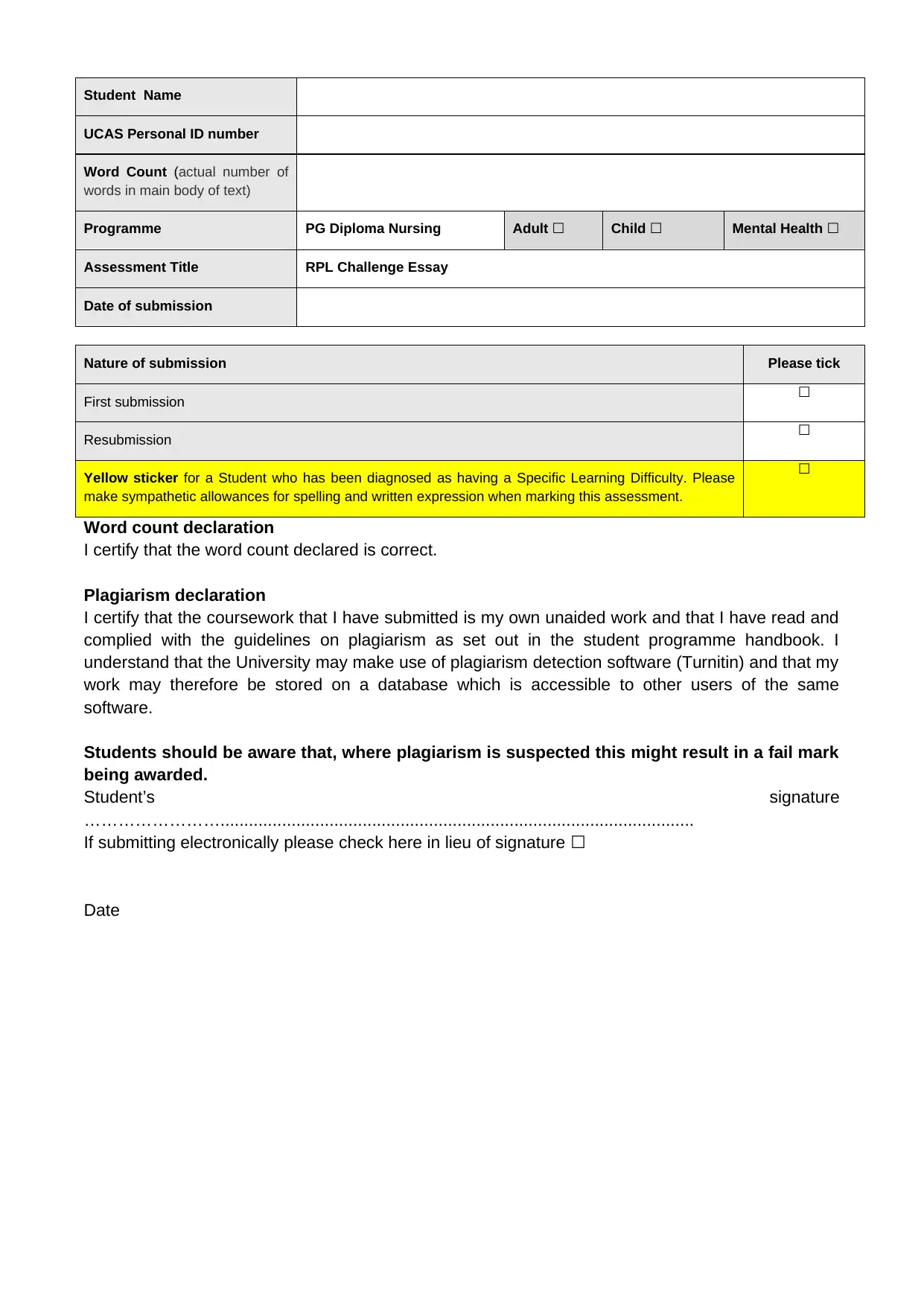
Student Name
UCAS Personal ID number
Word Count (actual number of
words in main body of text)
Programme PG Diploma Nursing Adult ☐ Child ☐ Mental Health ☐
Assessment Title RPL Challenge Essay
Date of submission
Nature of submission Please tick
First submission ☐
Resubmission ☐
Yellow sticker for a Student who has been diagnosed as having a Specific Learning Difficulty. Please
make sympathetic allowances for spelling and written expression when marking this assessment.
☐
Word count declaration
I certify that the word count declared is correct.
Plagiarism declaration
I certify that the coursework that I have submitted is my own unaided work and that I have read and
complied with the guidelines on plagiarism as set out in the student programme handbook. I
understand that the University may make use of plagiarism detection software (Turnitin) and that my
work may therefore be stored on a database which is accessible to other users of the same
software.
Students should be aware that, where plagiarism is suspected this might result in a fail mark
being awarded.
Student’s signature
……………………....................................................................................................
If submitting electronically please check here in lieu of signature ☐
Date
UCAS Personal ID number
Word Count (actual number of
words in main body of text)
Programme PG Diploma Nursing Adult ☐ Child ☐ Mental Health ☐
Assessment Title RPL Challenge Essay
Date of submission
Nature of submission Please tick
First submission ☐
Resubmission ☐
Yellow sticker for a Student who has been diagnosed as having a Specific Learning Difficulty. Please
make sympathetic allowances for spelling and written expression when marking this assessment.
☐
Word count declaration
I certify that the word count declared is correct.
Plagiarism declaration
I certify that the coursework that I have submitted is my own unaided work and that I have read and
complied with the guidelines on plagiarism as set out in the student programme handbook. I
understand that the University may make use of plagiarism detection software (Turnitin) and that my
work may therefore be stored on a database which is accessible to other users of the same
software.
Students should be aware that, where plagiarism is suspected this might result in a fail mark
being awarded.
Student’s signature
……………………....................................................................................................
If submitting electronically please check here in lieu of signature ☐
Date
Secure Best Marks with AI Grader
Need help grading? Try our AI Grader for instant feedback on your assignments.
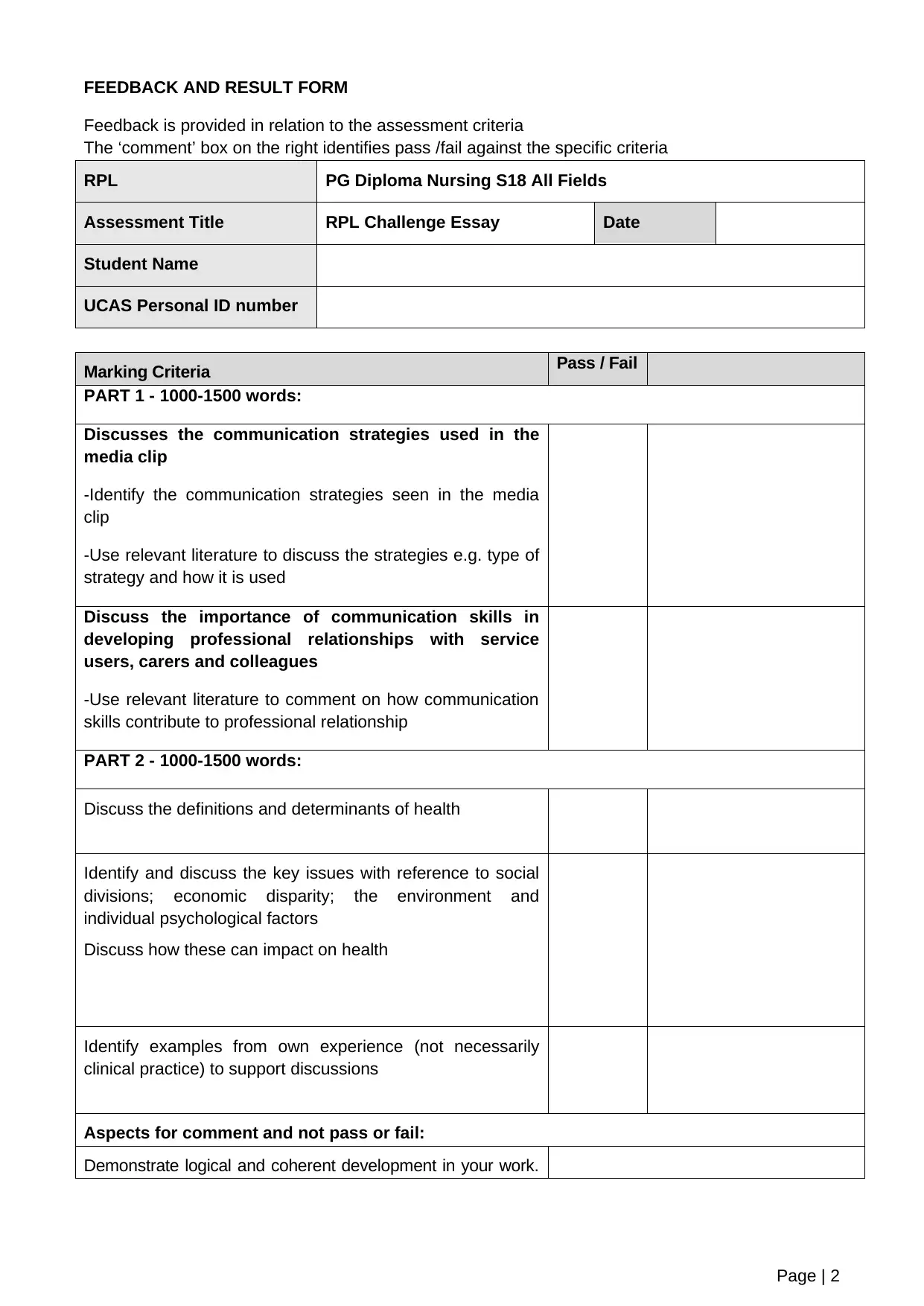
FEEDBACK AND RESULT FORM
Feedback is provided in relation to the assessment criteria
The ‘comment’ box on the right identifies pass /fail against the specific criteria
RPL PG Diploma Nursing S18 All Fields
Assessment Title RPL Challenge Essay Date
Student Name
UCAS Personal ID number
Marking Criteria Pass / Fail
PART 1 - 1000-1500 words:
Discusses the communication strategies used in the
media clip
-Identify the communication strategies seen in the media
clip
-Use relevant literature to discuss the strategies e.g. type of
strategy and how it is used
Discuss the importance of communication skills in
developing professional relationships with service
users, carers and colleagues
-Use relevant literature to comment on how communication
skills contribute to professional relationship
PART 2 - 1000-1500 words:
Discuss the definitions and determinants of health
Identify and discuss the key issues with reference to social
divisions; economic disparity; the environment and
individual psychological factors
Discuss how these can impact on health
Identify examples from own experience (not necessarily
clinical practice) to support discussions
Aspects for comment and not pass or fail:
Demonstrate logical and coherent development in your work.
Page | 2
Feedback is provided in relation to the assessment criteria
The ‘comment’ box on the right identifies pass /fail against the specific criteria
RPL PG Diploma Nursing S18 All Fields
Assessment Title RPL Challenge Essay Date
Student Name
UCAS Personal ID number
Marking Criteria Pass / Fail
PART 1 - 1000-1500 words:
Discusses the communication strategies used in the
media clip
-Identify the communication strategies seen in the media
clip
-Use relevant literature to discuss the strategies e.g. type of
strategy and how it is used
Discuss the importance of communication skills in
developing professional relationships with service
users, carers and colleagues
-Use relevant literature to comment on how communication
skills contribute to professional relationship
PART 2 - 1000-1500 words:
Discuss the definitions and determinants of health
Identify and discuss the key issues with reference to social
divisions; economic disparity; the environment and
individual psychological factors
Discuss how these can impact on health
Identify examples from own experience (not necessarily
clinical practice) to support discussions
Aspects for comment and not pass or fail:
Demonstrate logical and coherent development in your work.
Page | 2
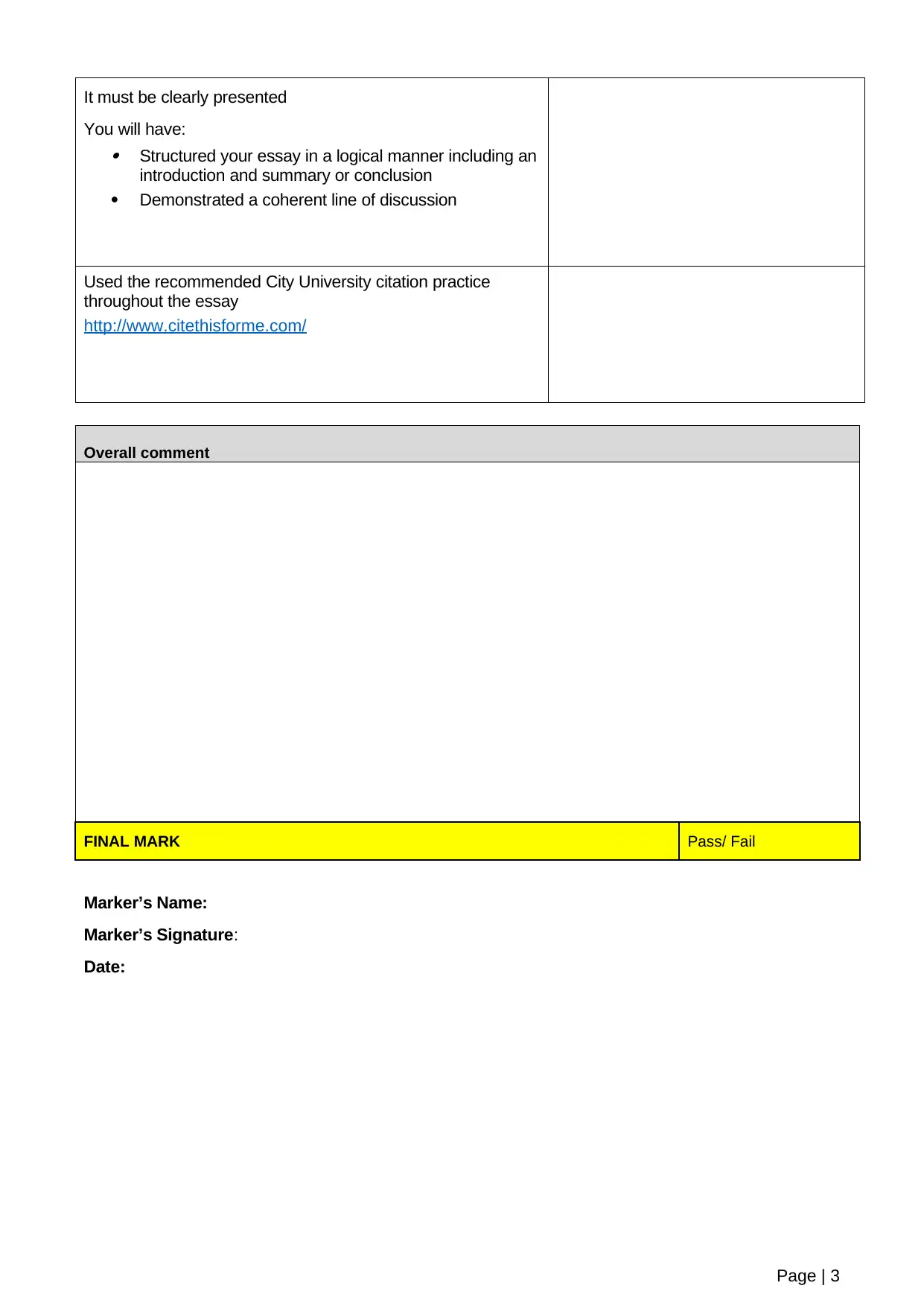
It must be clearly presented
You will have: Structured your essay in a logical manner including an
introduction and summary or conclusion
Demonstrated a coherent line of discussion
Used the recommended City University citation practice
throughout the essay
http://www.citethisforme.com/
Overall comment
FINAL MARK Pass/ Fail
Marker’s Name:
Marker’s Signature:
Date:
Page | 3
You will have: Structured your essay in a logical manner including an
introduction and summary or conclusion
Demonstrated a coherent line of discussion
Used the recommended City University citation practice
throughout the essay
http://www.citethisforme.com/
Overall comment
FINAL MARK Pass/ Fail
Marker’s Name:
Marker’s Signature:
Date:
Page | 3
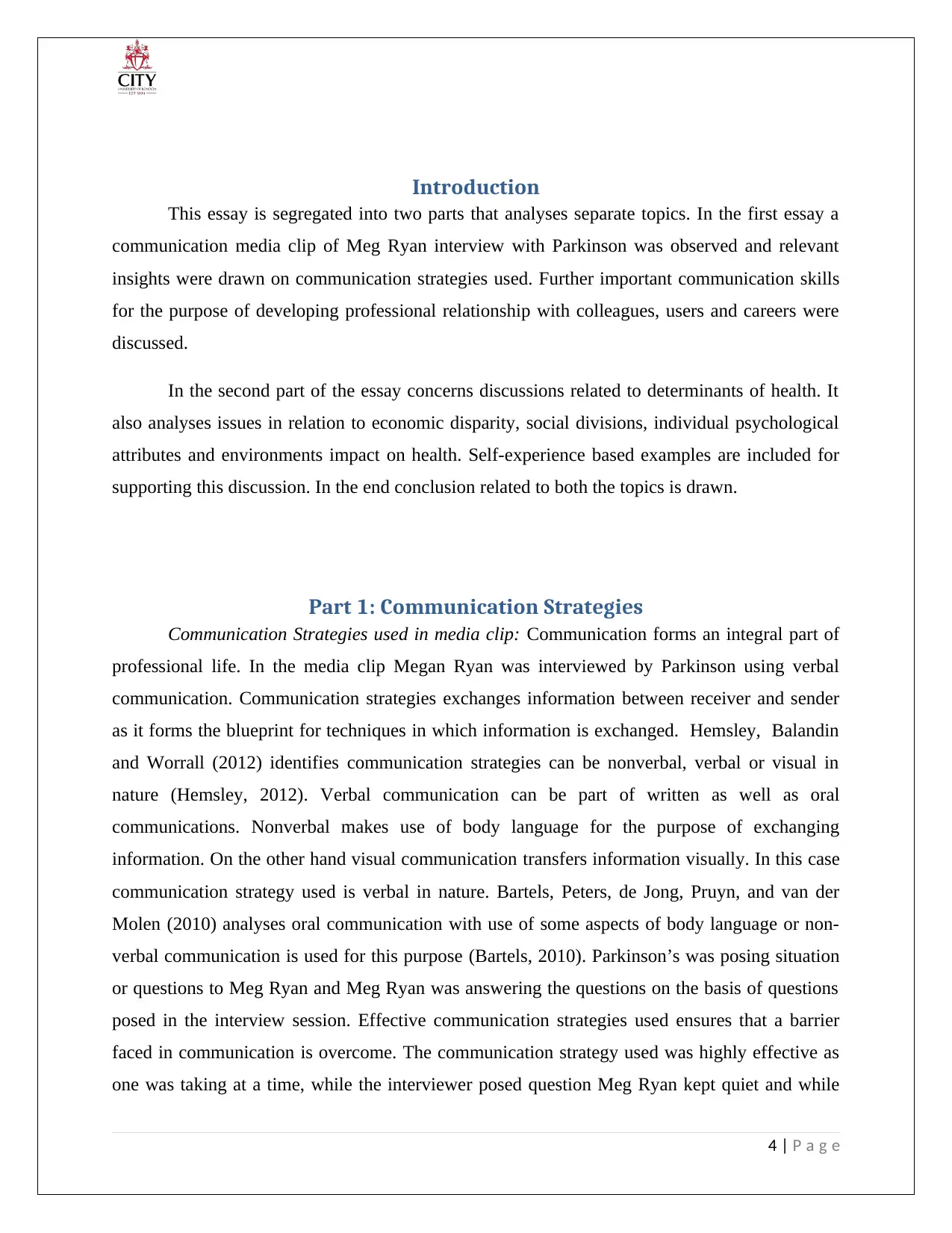
Introduction
This essay is segregated into two parts that analyses separate topics. In the first essay a
communication media clip of Meg Ryan interview with Parkinson was observed and relevant
insights were drawn on communication strategies used. Further important communication skills
for the purpose of developing professional relationship with colleagues, users and careers were
discussed.
In the second part of the essay concerns discussions related to determinants of health. It
also analyses issues in relation to economic disparity, social divisions, individual psychological
attributes and environments impact on health. Self-experience based examples are included for
supporting this discussion. In the end conclusion related to both the topics is drawn.
Part 1: Communication Strategies
Communication Strategies used in media clip: Communication forms an integral part of
professional life. In the media clip Megan Ryan was interviewed by Parkinson using verbal
communication. Communication strategies exchanges information between receiver and sender
as it forms the blueprint for techniques in which information is exchanged. Hemsley, Balandin
and Worrall (2012) identifies communication strategies can be nonverbal, verbal or visual in
nature (Hemsley, 2012). Verbal communication can be part of written as well as oral
communications. Nonverbal makes use of body language for the purpose of exchanging
information. On the other hand visual communication transfers information visually. In this case
communication strategy used is verbal in nature. Bartels, Peters, de Jong, Pruyn, and van der
Molen (2010) analyses oral communication with use of some aspects of body language or non-
verbal communication is used for this purpose (Bartels, 2010). Parkinson’s was posing situation
or questions to Meg Ryan and Meg Ryan was answering the questions on the basis of questions
posed in the interview session. Effective communication strategies used ensures that a barrier
faced in communication is overcome. The communication strategy used was highly effective as
one was taking at a time, while the interviewer posed question Meg Ryan kept quiet and while
4 | P a g e
This essay is segregated into two parts that analyses separate topics. In the first essay a
communication media clip of Meg Ryan interview with Parkinson was observed and relevant
insights were drawn on communication strategies used. Further important communication skills
for the purpose of developing professional relationship with colleagues, users and careers were
discussed.
In the second part of the essay concerns discussions related to determinants of health. It
also analyses issues in relation to economic disparity, social divisions, individual psychological
attributes and environments impact on health. Self-experience based examples are included for
supporting this discussion. In the end conclusion related to both the topics is drawn.
Part 1: Communication Strategies
Communication Strategies used in media clip: Communication forms an integral part of
professional life. In the media clip Megan Ryan was interviewed by Parkinson using verbal
communication. Communication strategies exchanges information between receiver and sender
as it forms the blueprint for techniques in which information is exchanged. Hemsley, Balandin
and Worrall (2012) identifies communication strategies can be nonverbal, verbal or visual in
nature (Hemsley, 2012). Verbal communication can be part of written as well as oral
communications. Nonverbal makes use of body language for the purpose of exchanging
information. On the other hand visual communication transfers information visually. In this case
communication strategy used is verbal in nature. Bartels, Peters, de Jong, Pruyn, and van der
Molen (2010) analyses oral communication with use of some aspects of body language or non-
verbal communication is used for this purpose (Bartels, 2010). Parkinson’s was posing situation
or questions to Meg Ryan and Meg Ryan was answering the questions on the basis of questions
posed in the interview session. Effective communication strategies used ensures that a barrier
faced in communication is overcome. The communication strategy used was highly effective as
one was taking at a time, while the interviewer posed question Meg Ryan kept quiet and while
4 | P a g e
Secure Best Marks with AI Grader
Need help grading? Try our AI Grader for instant feedback on your assignments.
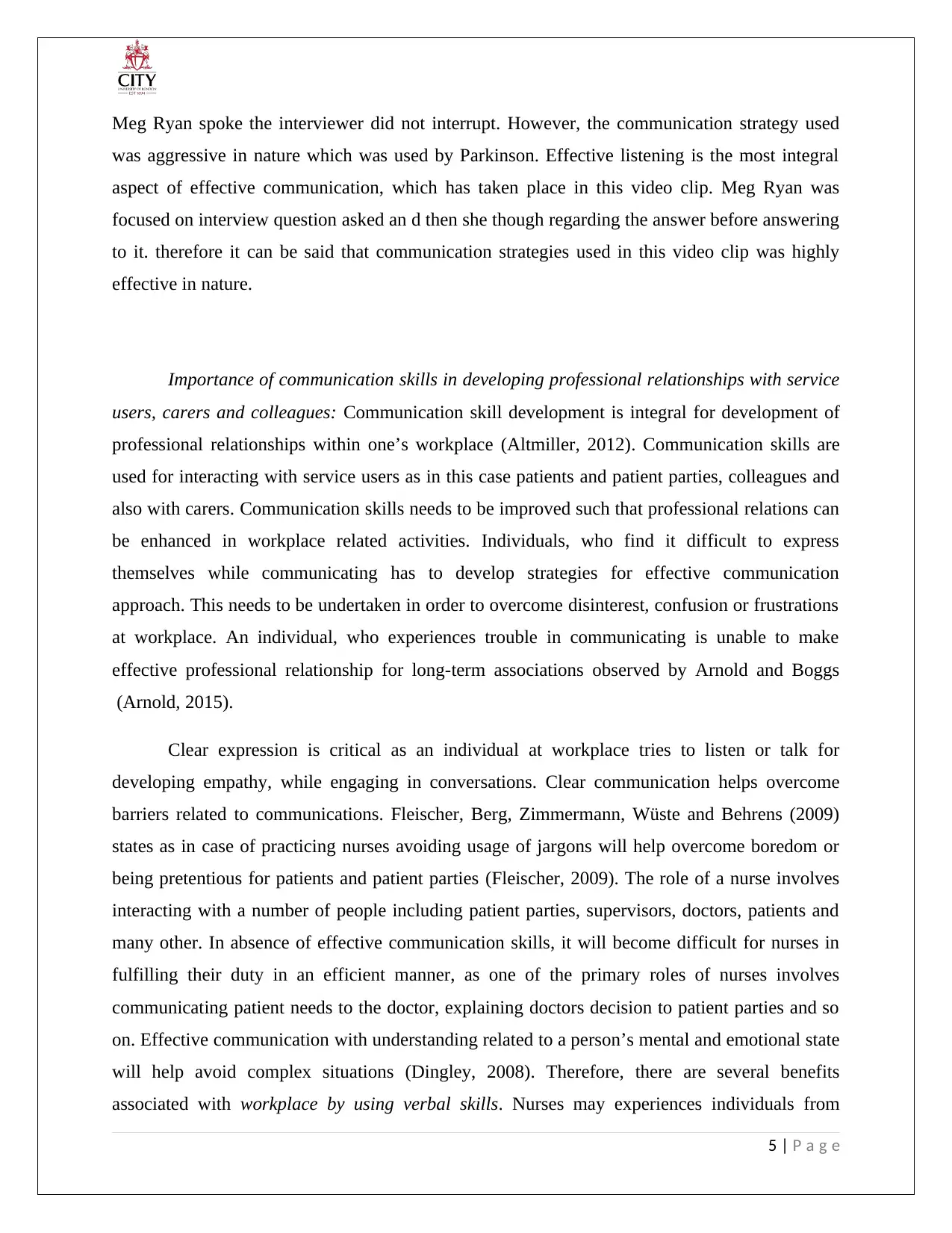
Meg Ryan spoke the interviewer did not interrupt. However, the communication strategy used
was aggressive in nature which was used by Parkinson. Effective listening is the most integral
aspect of effective communication, which has taken place in this video clip. Meg Ryan was
focused on interview question asked an d then she though regarding the answer before answering
to it. therefore it can be said that communication strategies used in this video clip was highly
effective in nature.
Importance of communication skills in developing professional relationships with service
users, carers and colleagues: Communication skill development is integral for development of
professional relationships within one’s workplace (Altmiller, 2012). Communication skills are
used for interacting with service users as in this case patients and patient parties, colleagues and
also with carers. Communication skills needs to be improved such that professional relations can
be enhanced in workplace related activities. Individuals, who find it difficult to express
themselves while communicating has to develop strategies for effective communication
approach. This needs to be undertaken in order to overcome disinterest, confusion or frustrations
at workplace. An individual, who experiences trouble in communicating is unable to make
effective professional relationship for long-term associations observed by Arnold and Boggs
(Arnold, 2015).
Clear expression is critical as an individual at workplace tries to listen or talk for
developing empathy, while engaging in conversations. Clear communication helps overcome
barriers related to communications. Fleischer, Berg, Zimmermann, Wüste and Behrens (2009)
states as in case of practicing nurses avoiding usage of jargons will help overcome boredom or
being pretentious for patients and patient parties (Fleischer, 2009). The role of a nurse involves
interacting with a number of people including patient parties, supervisors, doctors, patients and
many other. In absence of effective communication skills, it will become difficult for nurses in
fulfilling their duty in an efficient manner, as one of the primary roles of nurses involves
communicating patient needs to the doctor, explaining doctors decision to patient parties and so
on. Effective communication with understanding related to a person’s mental and emotional state
will help avoid complex situations (Dingley, 2008). Therefore, there are several benefits
associated with workplace by using verbal skills. Nurses may experiences individuals from
5 | P a g e
was aggressive in nature which was used by Parkinson. Effective listening is the most integral
aspect of effective communication, which has taken place in this video clip. Meg Ryan was
focused on interview question asked an d then she though regarding the answer before answering
to it. therefore it can be said that communication strategies used in this video clip was highly
effective in nature.
Importance of communication skills in developing professional relationships with service
users, carers and colleagues: Communication skill development is integral for development of
professional relationships within one’s workplace (Altmiller, 2012). Communication skills are
used for interacting with service users as in this case patients and patient parties, colleagues and
also with carers. Communication skills needs to be improved such that professional relations can
be enhanced in workplace related activities. Individuals, who find it difficult to express
themselves while communicating has to develop strategies for effective communication
approach. This needs to be undertaken in order to overcome disinterest, confusion or frustrations
at workplace. An individual, who experiences trouble in communicating is unable to make
effective professional relationship for long-term associations observed by Arnold and Boggs
(Arnold, 2015).
Clear expression is critical as an individual at workplace tries to listen or talk for
developing empathy, while engaging in conversations. Clear communication helps overcome
barriers related to communications. Fleischer, Berg, Zimmermann, Wüste and Behrens (2009)
states as in case of practicing nurses avoiding usage of jargons will help overcome boredom or
being pretentious for patients and patient parties (Fleischer, 2009). The role of a nurse involves
interacting with a number of people including patient parties, supervisors, doctors, patients and
many other. In absence of effective communication skills, it will become difficult for nurses in
fulfilling their duty in an efficient manner, as one of the primary roles of nurses involves
communicating patient needs to the doctor, explaining doctors decision to patient parties and so
on. Effective communication with understanding related to a person’s mental and emotional state
will help avoid complex situations (Dingley, 2008). Therefore, there are several benefits
associated with workplace by using verbal skills. Nurses may experiences individuals from
5 | P a g e
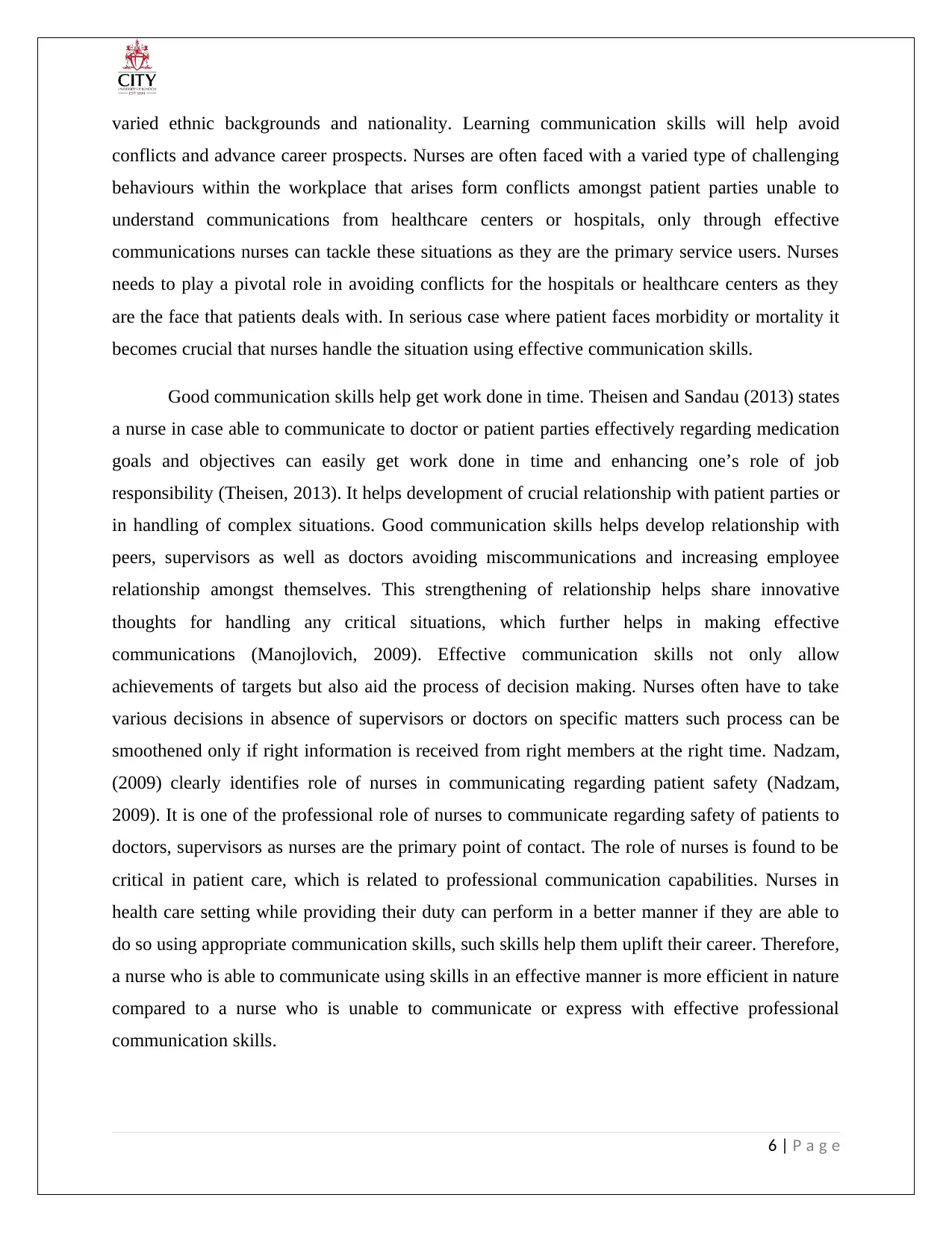
varied ethnic backgrounds and nationality. Learning communication skills will help avoid
conflicts and advance career prospects. Nurses are often faced with a varied type of challenging
behaviours within the workplace that arises form conflicts amongst patient parties unable to
understand communications from healthcare centers or hospitals, only through effective
communications nurses can tackle these situations as they are the primary service users. Nurses
needs to play a pivotal role in avoiding conflicts for the hospitals or healthcare centers as they
are the face that patients deals with. In serious case where patient faces morbidity or mortality it
becomes crucial that nurses handle the situation using effective communication skills.
Good communication skills help get work done in time. Theisen and Sandau (2013) states
a nurse in case able to communicate to doctor or patient parties effectively regarding medication
goals and objectives can easily get work done in time and enhancing one’s role of job
responsibility (Theisen, 2013). It helps development of crucial relationship with patient parties or
in handling of complex situations. Good communication skills helps develop relationship with
peers, supervisors as well as doctors avoiding miscommunications and increasing employee
relationship amongst themselves. This strengthening of relationship helps share innovative
thoughts for handling any critical situations, which further helps in making effective
communications (Manojlovich, 2009). Effective communication skills not only allow
achievements of targets but also aid the process of decision making. Nurses often have to take
various decisions in absence of supervisors or doctors on specific matters such process can be
smoothened only if right information is received from right members at the right time. Nadzam,
(2009) clearly identifies role of nurses in communicating regarding patient safety (Nadzam,
2009). It is one of the professional role of nurses to communicate regarding safety of patients to
doctors, supervisors as nurses are the primary point of contact. The role of nurses is found to be
critical in patient care, which is related to professional communication capabilities. Nurses in
health care setting while providing their duty can perform in a better manner if they are able to
do so using appropriate communication skills, such skills help them uplift their career. Therefore,
a nurse who is able to communicate using skills in an effective manner is more efficient in nature
compared to a nurse who is unable to communicate or express with effective professional
communication skills.
6 | P a g e
conflicts and advance career prospects. Nurses are often faced with a varied type of challenging
behaviours within the workplace that arises form conflicts amongst patient parties unable to
understand communications from healthcare centers or hospitals, only through effective
communications nurses can tackle these situations as they are the primary service users. Nurses
needs to play a pivotal role in avoiding conflicts for the hospitals or healthcare centers as they
are the face that patients deals with. In serious case where patient faces morbidity or mortality it
becomes crucial that nurses handle the situation using effective communication skills.
Good communication skills help get work done in time. Theisen and Sandau (2013) states
a nurse in case able to communicate to doctor or patient parties effectively regarding medication
goals and objectives can easily get work done in time and enhancing one’s role of job
responsibility (Theisen, 2013). It helps development of crucial relationship with patient parties or
in handling of complex situations. Good communication skills helps develop relationship with
peers, supervisors as well as doctors avoiding miscommunications and increasing employee
relationship amongst themselves. This strengthening of relationship helps share innovative
thoughts for handling any critical situations, which further helps in making effective
communications (Manojlovich, 2009). Effective communication skills not only allow
achievements of targets but also aid the process of decision making. Nurses often have to take
various decisions in absence of supervisors or doctors on specific matters such process can be
smoothened only if right information is received from right members at the right time. Nadzam,
(2009) clearly identifies role of nurses in communicating regarding patient safety (Nadzam,
2009). It is one of the professional role of nurses to communicate regarding safety of patients to
doctors, supervisors as nurses are the primary point of contact. The role of nurses is found to be
critical in patient care, which is related to professional communication capabilities. Nurses in
health care setting while providing their duty can perform in a better manner if they are able to
do so using appropriate communication skills, such skills help them uplift their career. Therefore,
a nurse who is able to communicate using skills in an effective manner is more efficient in nature
compared to a nurse who is unable to communicate or express with effective professional
communication skills.
6 | P a g e
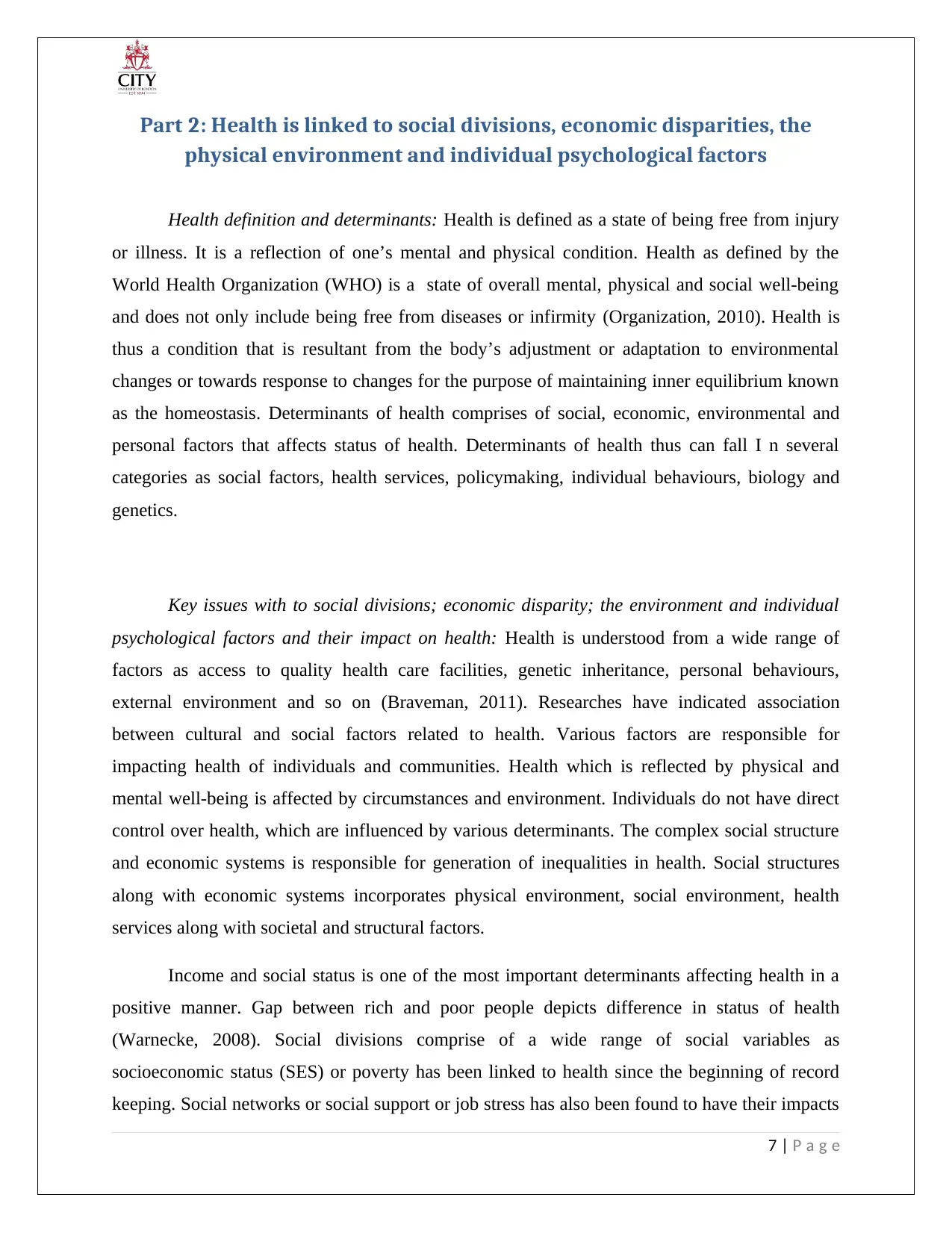
Part 2: Health is linked to social divisions, economic disparities, the
physical environment and individual psychological factors
Health definition and determinants: Health is defined as a state of being free from injury
or illness. It is a reflection of one’s mental and physical condition. Health as defined by the
World Health Organization (WHO) is a state of overall mental, physical and social well-being
and does not only include being free from diseases or infirmity (Organization, 2010). Health is
thus a condition that is resultant from the body’s adjustment or adaptation to environmental
changes or towards response to changes for the purpose of maintaining inner equilibrium known
as the homeostasis. Determinants of health comprises of social, economic, environmental and
personal factors that affects status of health. Determinants of health thus can fall I n several
categories as social factors, health services, policymaking, individual behaviours, biology and
genetics.
Key issues with to social divisions; economic disparity; the environment and individual
psychological factors and their impact on health: Health is understood from a wide range of
factors as access to quality health care facilities, genetic inheritance, personal behaviours,
external environment and so on (Braveman, 2011). Researches have indicated association
between cultural and social factors related to health. Various factors are responsible for
impacting health of individuals and communities. Health which is reflected by physical and
mental well-being is affected by circumstances and environment. Individuals do not have direct
control over health, which are influenced by various determinants. The complex social structure
and economic systems is responsible for generation of inequalities in health. Social structures
along with economic systems incorporates physical environment, social environment, health
services along with societal and structural factors.
Income and social status is one of the most important determinants affecting health in a
positive manner. Gap between rich and poor people depicts difference in status of health
(Warnecke, 2008). Social divisions comprise of a wide range of social variables as
socioeconomic status (SES) or poverty has been linked to health since the beginning of record
keeping. Social networks or social support or job stress has also been found to have their impacts
7 | P a g e
physical environment and individual psychological factors
Health definition and determinants: Health is defined as a state of being free from injury
or illness. It is a reflection of one’s mental and physical condition. Health as defined by the
World Health Organization (WHO) is a state of overall mental, physical and social well-being
and does not only include being free from diseases or infirmity (Organization, 2010). Health is
thus a condition that is resultant from the body’s adjustment or adaptation to environmental
changes or towards response to changes for the purpose of maintaining inner equilibrium known
as the homeostasis. Determinants of health comprises of social, economic, environmental and
personal factors that affects status of health. Determinants of health thus can fall I n several
categories as social factors, health services, policymaking, individual behaviours, biology and
genetics.
Key issues with to social divisions; economic disparity; the environment and individual
psychological factors and their impact on health: Health is understood from a wide range of
factors as access to quality health care facilities, genetic inheritance, personal behaviours,
external environment and so on (Braveman, 2011). Researches have indicated association
between cultural and social factors related to health. Various factors are responsible for
impacting health of individuals and communities. Health which is reflected by physical and
mental well-being is affected by circumstances and environment. Individuals do not have direct
control over health, which are influenced by various determinants. The complex social structure
and economic systems is responsible for generation of inequalities in health. Social structures
along with economic systems incorporates physical environment, social environment, health
services along with societal and structural factors.
Income and social status is one of the most important determinants affecting health in a
positive manner. Gap between rich and poor people depicts difference in status of health
(Warnecke, 2008). Social divisions comprise of a wide range of social variables as
socioeconomic status (SES) or poverty has been linked to health since the beginning of record
keeping. Social networks or social support or job stress has also been found to have their impacts
7 | P a g e
Paraphrase This Document
Need a fresh take? Get an instant paraphrase of this document with our AI Paraphraser
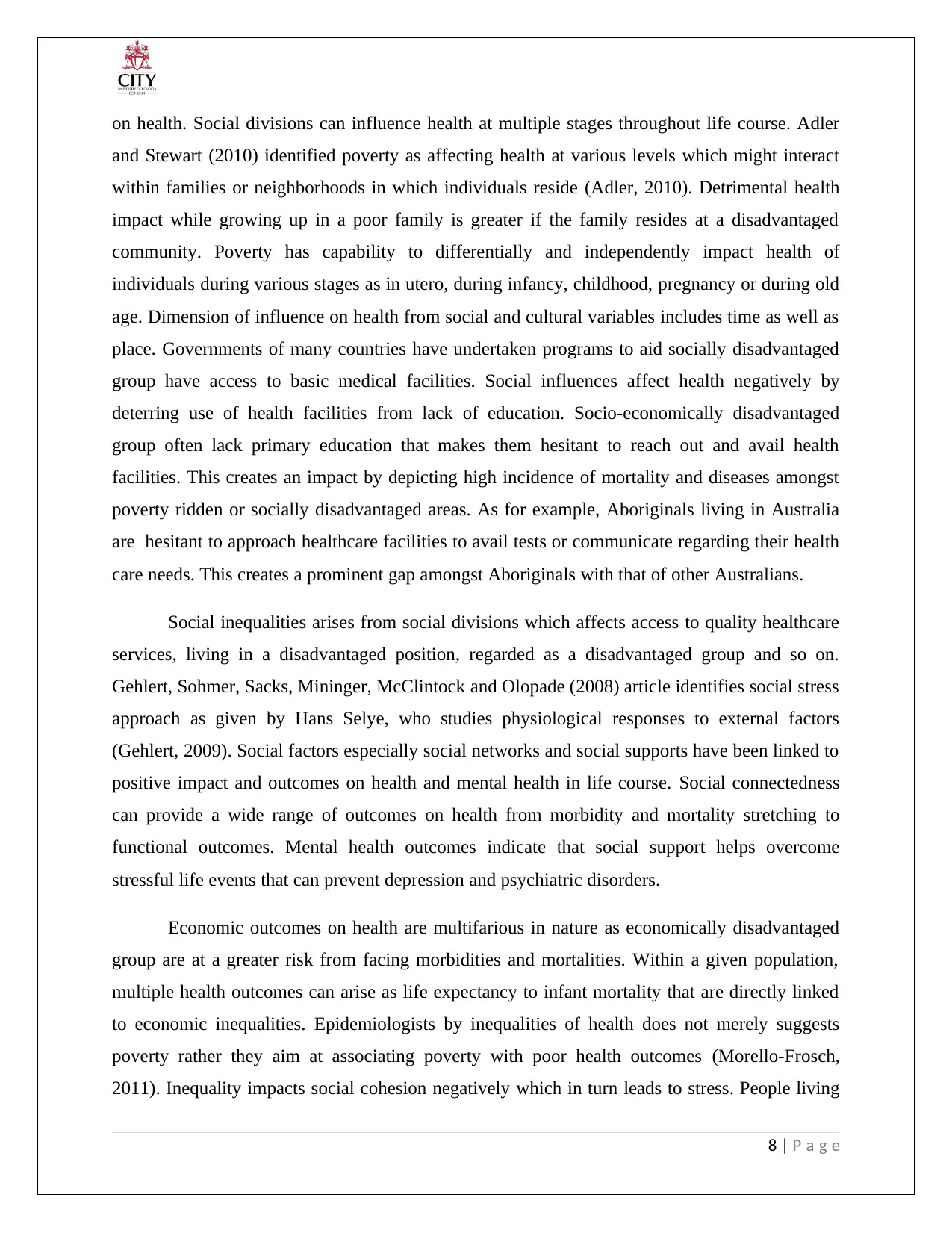
on health. Social divisions can influence health at multiple stages throughout life course. Adler
and Stewart (2010) identified poverty as affecting health at various levels which might interact
within families or neighborhoods in which individuals reside (Adler, 2010). Detrimental health
impact while growing up in a poor family is greater if the family resides at a disadvantaged
community. Poverty has capability to differentially and independently impact health of
individuals during various stages as in utero, during infancy, childhood, pregnancy or during old
age. Dimension of influence on health from social and cultural variables includes time as well as
place. Governments of many countries have undertaken programs to aid socially disadvantaged
group have access to basic medical facilities. Social influences affect health negatively by
deterring use of health facilities from lack of education. Socio-economically disadvantaged
group often lack primary education that makes them hesitant to reach out and avail health
facilities. This creates an impact by depicting high incidence of mortality and diseases amongst
poverty ridden or socially disadvantaged areas. As for example, Aboriginals living in Australia
are hesitant to approach healthcare facilities to avail tests or communicate regarding their health
care needs. This creates a prominent gap amongst Aboriginals with that of other Australians.
Social inequalities arises from social divisions which affects access to quality healthcare
services, living in a disadvantaged position, regarded as a disadvantaged group and so on.
Gehlert, Sohmer, Sacks, Mininger, McClintock and Olopade (2008) article identifies social stress
approach as given by Hans Selye, who studies physiological responses to external factors
(Gehlert, 2009). Social factors especially social networks and social supports have been linked to
positive impact and outcomes on health and mental health in life course. Social connectedness
can provide a wide range of outcomes on health from morbidity and mortality stretching to
functional outcomes. Mental health outcomes indicate that social support helps overcome
stressful life events that can prevent depression and psychiatric disorders.
Economic outcomes on health are multifarious in nature as economically disadvantaged
group are at a greater risk from facing morbidities and mortalities. Within a given population,
multiple health outcomes can arise as life expectancy to infant mortality that are directly linked
to economic inequalities. Epidemiologists by inequalities of health does not merely suggests
poverty rather they aim at associating poverty with poor health outcomes (Morello-Frosch,
2011). Inequality impacts social cohesion negatively which in turn leads to stress. People living
8 | P a g e
and Stewart (2010) identified poverty as affecting health at various levels which might interact
within families or neighborhoods in which individuals reside (Adler, 2010). Detrimental health
impact while growing up in a poor family is greater if the family resides at a disadvantaged
community. Poverty has capability to differentially and independently impact health of
individuals during various stages as in utero, during infancy, childhood, pregnancy or during old
age. Dimension of influence on health from social and cultural variables includes time as well as
place. Governments of many countries have undertaken programs to aid socially disadvantaged
group have access to basic medical facilities. Social influences affect health negatively by
deterring use of health facilities from lack of education. Socio-economically disadvantaged
group often lack primary education that makes them hesitant to reach out and avail health
facilities. This creates an impact by depicting high incidence of mortality and diseases amongst
poverty ridden or socially disadvantaged areas. As for example, Aboriginals living in Australia
are hesitant to approach healthcare facilities to avail tests or communicate regarding their health
care needs. This creates a prominent gap amongst Aboriginals with that of other Australians.
Social inequalities arises from social divisions which affects access to quality healthcare
services, living in a disadvantaged position, regarded as a disadvantaged group and so on.
Gehlert, Sohmer, Sacks, Mininger, McClintock and Olopade (2008) article identifies social stress
approach as given by Hans Selye, who studies physiological responses to external factors
(Gehlert, 2009). Social factors especially social networks and social supports have been linked to
positive impact and outcomes on health and mental health in life course. Social connectedness
can provide a wide range of outcomes on health from morbidity and mortality stretching to
functional outcomes. Mental health outcomes indicate that social support helps overcome
stressful life events that can prevent depression and psychiatric disorders.
Economic outcomes on health are multifarious in nature as economically disadvantaged
group are at a greater risk from facing morbidities and mortalities. Within a given population,
multiple health outcomes can arise as life expectancy to infant mortality that are directly linked
to economic inequalities. Epidemiologists by inequalities of health does not merely suggests
poverty rather they aim at associating poverty with poor health outcomes (Morello-Frosch,
2011). Inequality impacts social cohesion negatively which in turn leads to stress. People living
8 | P a g e
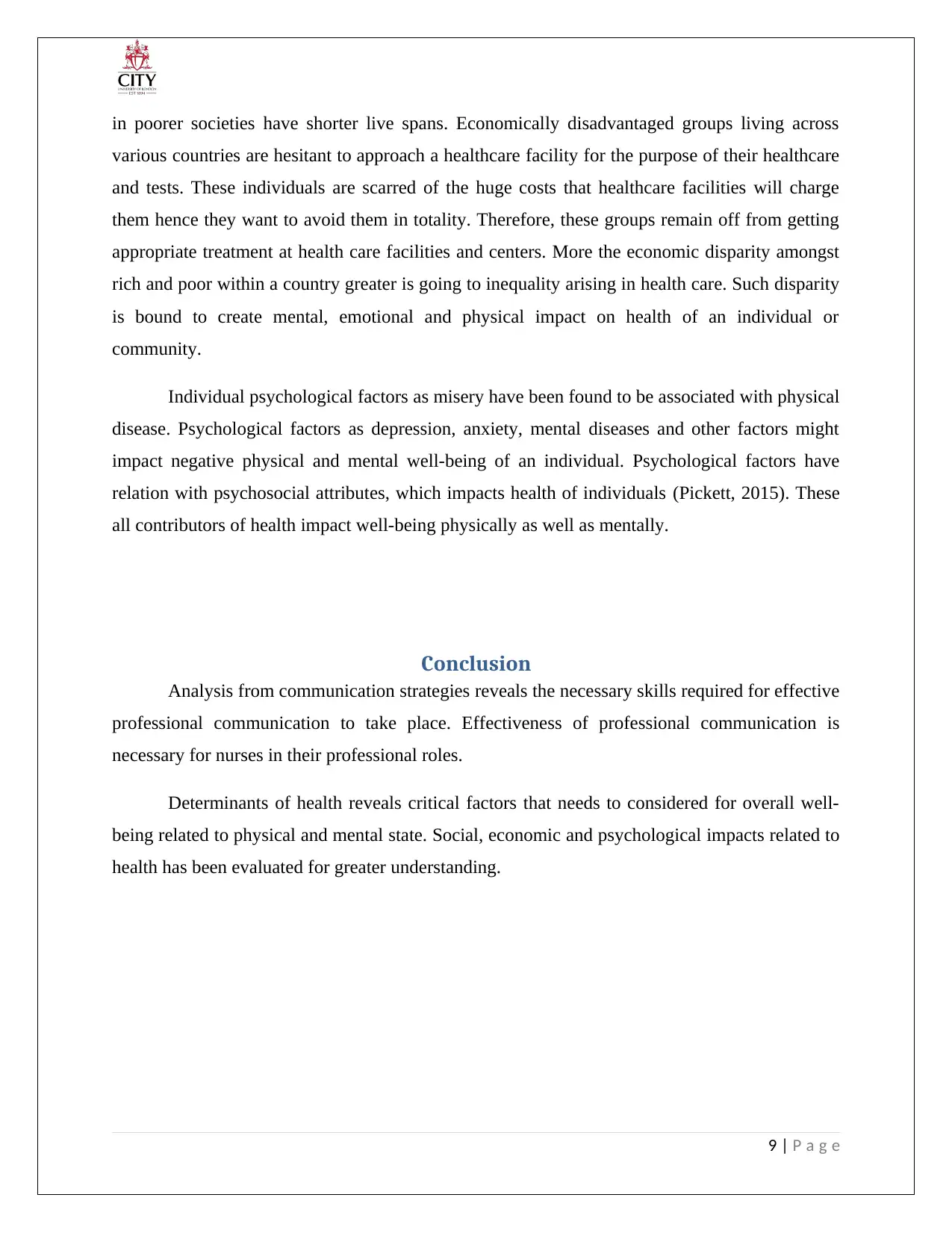
in poorer societies have shorter live spans. Economically disadvantaged groups living across
various countries are hesitant to approach a healthcare facility for the purpose of their healthcare
and tests. These individuals are scarred of the huge costs that healthcare facilities will charge
them hence they want to avoid them in totality. Therefore, these groups remain off from getting
appropriate treatment at health care facilities and centers. More the economic disparity amongst
rich and poor within a country greater is going to inequality arising in health care. Such disparity
is bound to create mental, emotional and physical impact on health of an individual or
community.
Individual psychological factors as misery have been found to be associated with physical
disease. Psychological factors as depression, anxiety, mental diseases and other factors might
impact negative physical and mental well-being of an individual. Psychological factors have
relation with psychosocial attributes, which impacts health of individuals (Pickett, 2015). These
all contributors of health impact well-being physically as well as mentally.
Conclusion
Analysis from communication strategies reveals the necessary skills required for effective
professional communication to take place. Effectiveness of professional communication is
necessary for nurses in their professional roles.
Determinants of health reveals critical factors that needs to considered for overall well-
being related to physical and mental state. Social, economic and psychological impacts related to
health has been evaluated for greater understanding.
9 | P a g e
various countries are hesitant to approach a healthcare facility for the purpose of their healthcare
and tests. These individuals are scarred of the huge costs that healthcare facilities will charge
them hence they want to avoid them in totality. Therefore, these groups remain off from getting
appropriate treatment at health care facilities and centers. More the economic disparity amongst
rich and poor within a country greater is going to inequality arising in health care. Such disparity
is bound to create mental, emotional and physical impact on health of an individual or
community.
Individual psychological factors as misery have been found to be associated with physical
disease. Psychological factors as depression, anxiety, mental diseases and other factors might
impact negative physical and mental well-being of an individual. Psychological factors have
relation with psychosocial attributes, which impacts health of individuals (Pickett, 2015). These
all contributors of health impact well-being physically as well as mentally.
Conclusion
Analysis from communication strategies reveals the necessary skills required for effective
professional communication to take place. Effectiveness of professional communication is
necessary for nurses in their professional roles.
Determinants of health reveals critical factors that needs to considered for overall well-
being related to physical and mental state. Social, economic and psychological impacts related to
health has been evaluated for greater understanding.
9 | P a g e
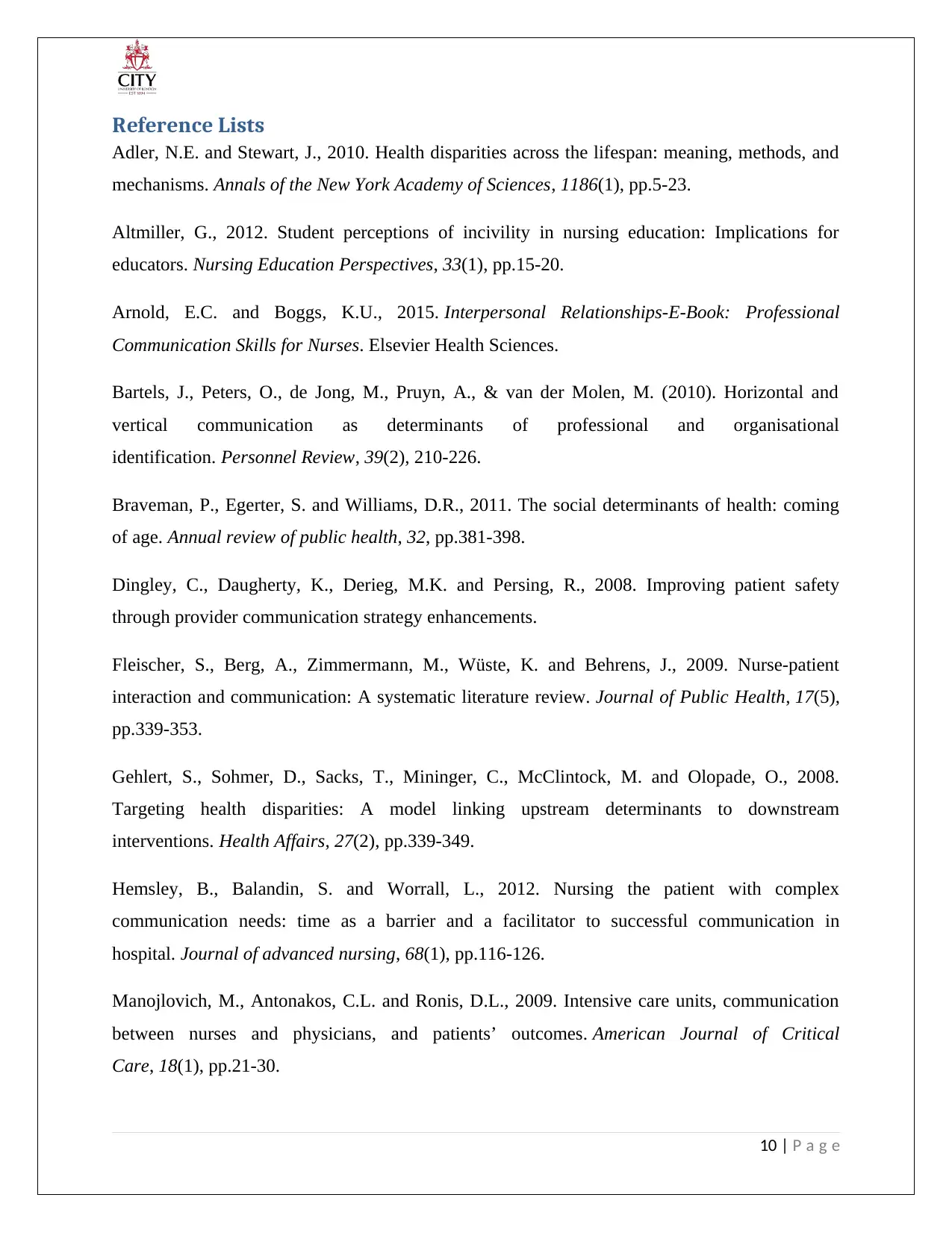
Reference Lists
Adler, N.E. and Stewart, J., 2010. Health disparities across the lifespan: meaning, methods, and
mechanisms. Annals of the New York Academy of Sciences, 1186(1), pp.5-23.
Altmiller, G., 2012. Student perceptions of incivility in nursing education: Implications for
educators. Nursing Education Perspectives, 33(1), pp.15-20.
Arnold, E.C. and Boggs, K.U., 2015. Interpersonal Relationships-E-Book: Professional
Communication Skills for Nurses. Elsevier Health Sciences.
Bartels, J., Peters, O., de Jong, M., Pruyn, A., & van der Molen, M. (2010). Horizontal and
vertical communication as determinants of professional and organisational
identification. Personnel Review, 39(2), 210-226.
Braveman, P., Egerter, S. and Williams, D.R., 2011. The social determinants of health: coming
of age. Annual review of public health, 32, pp.381-398.
Dingley, C., Daugherty, K., Derieg, M.K. and Persing, R., 2008. Improving patient safety
through provider communication strategy enhancements.
Fleischer, S., Berg, A., Zimmermann, M., Wüste, K. and Behrens, J., 2009. Nurse-patient
interaction and communication: A systematic literature review. Journal of Public Health, 17(5),
pp.339-353.
Gehlert, S., Sohmer, D., Sacks, T., Mininger, C., McClintock, M. and Olopade, O., 2008.
Targeting health disparities: A model linking upstream determinants to downstream
interventions. Health Affairs, 27(2), pp.339-349.
Hemsley, B., Balandin, S. and Worrall, L., 2012. Nursing the patient with complex
communication needs: time as a barrier and a facilitator to successful communication in
hospital. Journal of advanced nursing, 68(1), pp.116-126.
Manojlovich, M., Antonakos, C.L. and Ronis, D.L., 2009. Intensive care units, communication
between nurses and physicians, and patients’ outcomes. American Journal of Critical
Care, 18(1), pp.21-30.
10 | P a g e
Adler, N.E. and Stewart, J., 2010. Health disparities across the lifespan: meaning, methods, and
mechanisms. Annals of the New York Academy of Sciences, 1186(1), pp.5-23.
Altmiller, G., 2012. Student perceptions of incivility in nursing education: Implications for
educators. Nursing Education Perspectives, 33(1), pp.15-20.
Arnold, E.C. and Boggs, K.U., 2015. Interpersonal Relationships-E-Book: Professional
Communication Skills for Nurses. Elsevier Health Sciences.
Bartels, J., Peters, O., de Jong, M., Pruyn, A., & van der Molen, M. (2010). Horizontal and
vertical communication as determinants of professional and organisational
identification. Personnel Review, 39(2), 210-226.
Braveman, P., Egerter, S. and Williams, D.R., 2011. The social determinants of health: coming
of age. Annual review of public health, 32, pp.381-398.
Dingley, C., Daugherty, K., Derieg, M.K. and Persing, R., 2008. Improving patient safety
through provider communication strategy enhancements.
Fleischer, S., Berg, A., Zimmermann, M., Wüste, K. and Behrens, J., 2009. Nurse-patient
interaction and communication: A systematic literature review. Journal of Public Health, 17(5),
pp.339-353.
Gehlert, S., Sohmer, D., Sacks, T., Mininger, C., McClintock, M. and Olopade, O., 2008.
Targeting health disparities: A model linking upstream determinants to downstream
interventions. Health Affairs, 27(2), pp.339-349.
Hemsley, B., Balandin, S. and Worrall, L., 2012. Nursing the patient with complex
communication needs: time as a barrier and a facilitator to successful communication in
hospital. Journal of advanced nursing, 68(1), pp.116-126.
Manojlovich, M., Antonakos, C.L. and Ronis, D.L., 2009. Intensive care units, communication
between nurses and physicians, and patients’ outcomes. American Journal of Critical
Care, 18(1), pp.21-30.
10 | P a g e
Secure Best Marks with AI Grader
Need help grading? Try our AI Grader for instant feedback on your assignments.
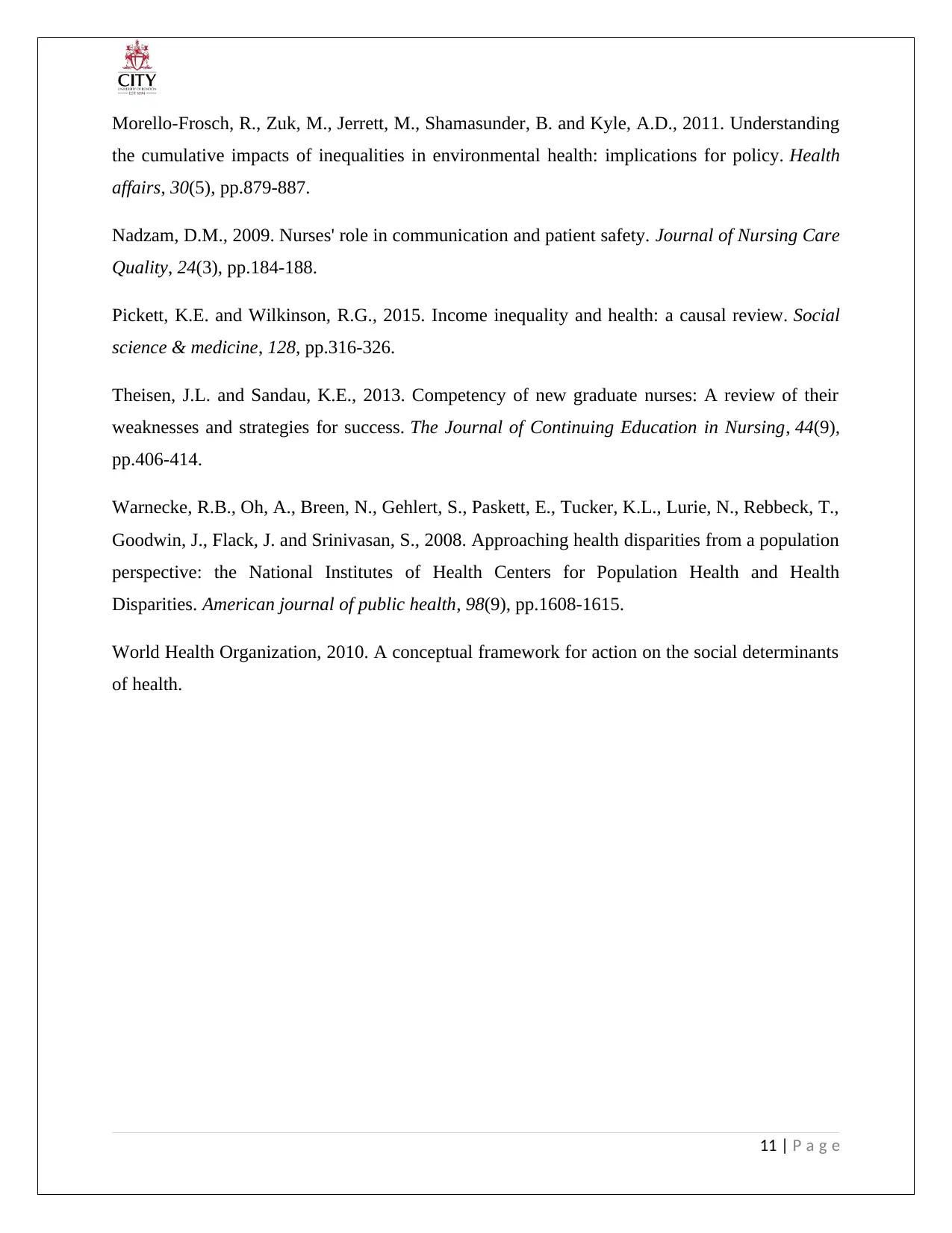
Morello-Frosch, R., Zuk, M., Jerrett, M., Shamasunder, B. and Kyle, A.D., 2011. Understanding
the cumulative impacts of inequalities in environmental health: implications for policy. Health
affairs, 30(5), pp.879-887.
Nadzam, D.M., 2009. Nurses' role in communication and patient safety. Journal of Nursing Care
Quality, 24(3), pp.184-188.
Pickett, K.E. and Wilkinson, R.G., 2015. Income inequality and health: a causal review. Social
science & medicine, 128, pp.316-326.
Theisen, J.L. and Sandau, K.E., 2013. Competency of new graduate nurses: A review of their
weaknesses and strategies for success. The Journal of Continuing Education in Nursing, 44(9),
pp.406-414.
Warnecke, R.B., Oh, A., Breen, N., Gehlert, S., Paskett, E., Tucker, K.L., Lurie, N., Rebbeck, T.,
Goodwin, J., Flack, J. and Srinivasan, S., 2008. Approaching health disparities from a population
perspective: the National Institutes of Health Centers for Population Health and Health
Disparities. American journal of public health, 98(9), pp.1608-1615.
World Health Organization, 2010. A conceptual framework for action on the social determinants
of health.
11 | P a g e
the cumulative impacts of inequalities in environmental health: implications for policy. Health
affairs, 30(5), pp.879-887.
Nadzam, D.M., 2009. Nurses' role in communication and patient safety. Journal of Nursing Care
Quality, 24(3), pp.184-188.
Pickett, K.E. and Wilkinson, R.G., 2015. Income inequality and health: a causal review. Social
science & medicine, 128, pp.316-326.
Theisen, J.L. and Sandau, K.E., 2013. Competency of new graduate nurses: A review of their
weaknesses and strategies for success. The Journal of Continuing Education in Nursing, 44(9),
pp.406-414.
Warnecke, R.B., Oh, A., Breen, N., Gehlert, S., Paskett, E., Tucker, K.L., Lurie, N., Rebbeck, T.,
Goodwin, J., Flack, J. and Srinivasan, S., 2008. Approaching health disparities from a population
perspective: the National Institutes of Health Centers for Population Health and Health
Disparities. American journal of public health, 98(9), pp.1608-1615.
World Health Organization, 2010. A conceptual framework for action on the social determinants
of health.
11 | P a g e
1 out of 11
Related Documents
Your All-in-One AI-Powered Toolkit for Academic Success.
+13062052269
info@desklib.com
Available 24*7 on WhatsApp / Email
![[object Object]](/_next/static/media/star-bottom.7253800d.svg)
Unlock your academic potential
© 2024 | Zucol Services PVT LTD | All rights reserved.




